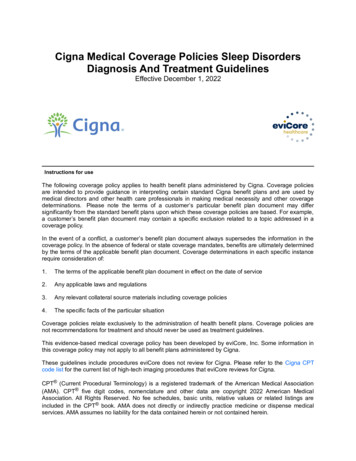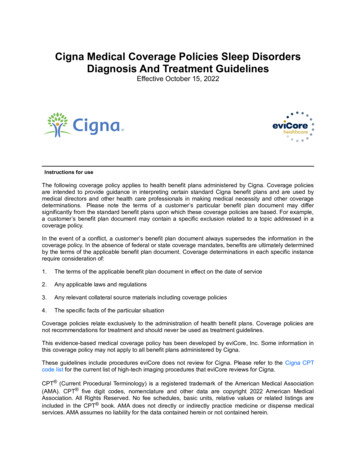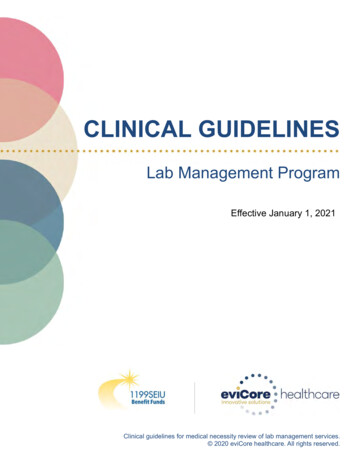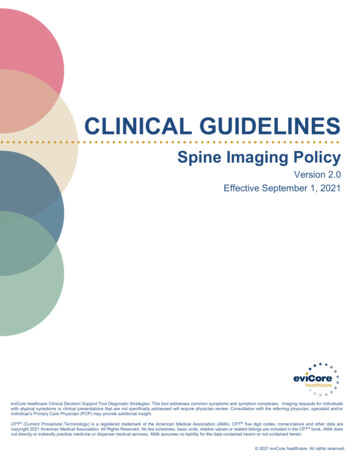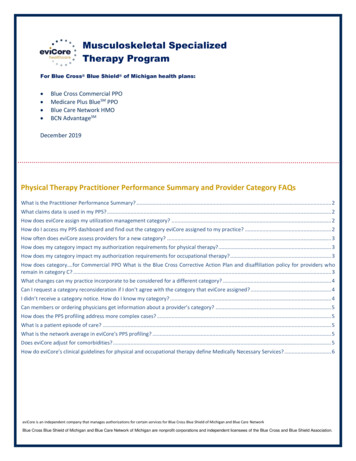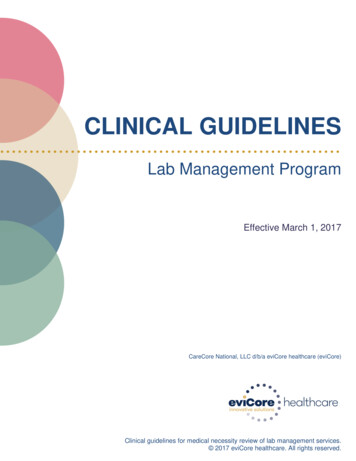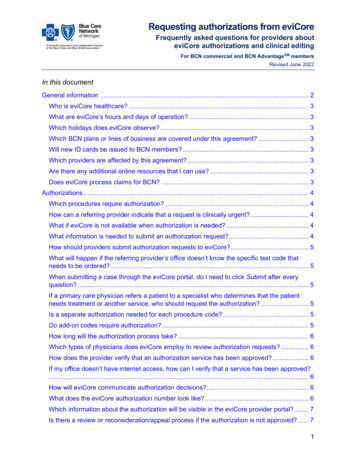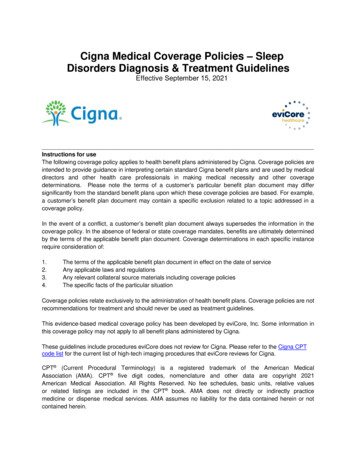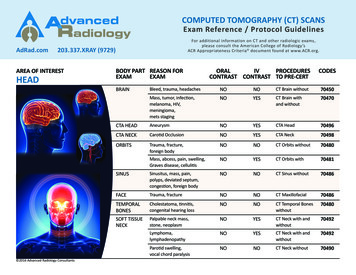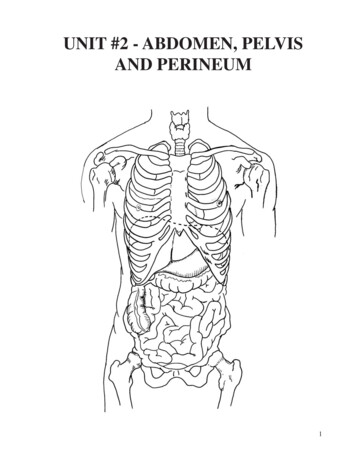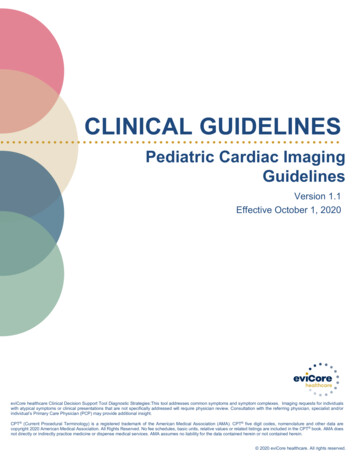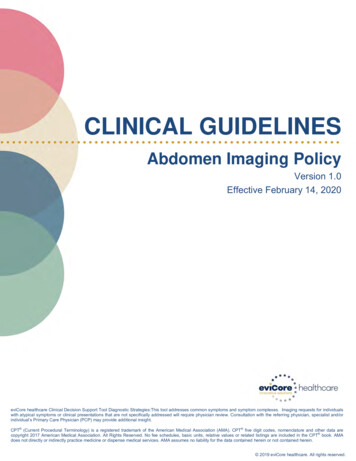
Transcription
CLINICAL GUIDELINESAbdomen Imaging PolicyVersion 1.0Effective February 14, 2020eviCore healthcare Clinical Decision Support Tool Diagnostic Strategies:This tool addresses common symptoms and symptom complexes. Imaging requests for individualswith atypical symptoms or clinical presentations that are not specifically addressed will require physician review. Consultation with the referring physician, specialist and/orindividual’s Primary Care Physician (PCP) may provide additional insight.CPT (Current Procedural Terminology) is a registered trademark of the American Medical Association (AMA). CPT five digit codes, nomenclature and other data arecopyright 2017 American Medical Association. All Rights Reserved. No fee schedules, basic units, relative values or related listings are included in the CPT book. AMAdoes not directly or indirectly practice medicine or dispense medical services. AMA assumes no liability for the data contained herein or not contained herein. 2019 eviCore healthcare. All rights reserved.
Abdomen Imaging GuidelinesV1.0Abdomen Imaging GuidelinesAbbreviations for Abdomen Imaging Guidelines4AB-1: General Guidelines6AB-2: Abdominal Pain12AB-3: Abdominal Sepsis (Suspected Abdominal Abscess)22AB-4: Flank Pain, Rule Out or Known Renal/Ureteral Stone24AB-5: Gastroenteritis28AB-6: Mesenteric/Colonic Ischemia30AB-7: Post-Operative Pain With-in 60 Days Following AbdominalSurgery – Abdominal Procedure33AB-8: Abdominal Lymphadenopathy35AB-9: Bariatric Surgery39AB-10: Blunt Abdominal Trauma41AB-11: Gaucher Disease and Hemochromatosis43AB-12: Hernias46AB-13: Abdominal Mass49AB-14: Lower Extremity Edema52AB-15: Zollinger-Ellison Syndrome (ZES-Gastrinoma)53AB-16: Adrenal Cortical Lesions55AB-17: Abdominal Aortic Aneurysm (AAA), Iliac Artery Aneurysm(IAA), and Visceral Artery Aneurysms Follow-Up of KnownAneurysms and Pre-Op Evaluation64AB-18: Abdominal Aortic Aneurysm (AAA) and Iliac ArteryAneurysm (IAA)-Post Endovascular or Open Aortic Repair66AB-19: Aortic Dissection and Imaging for Other Aortic Conditions 68AB-20: Bowel Obstruction and Gastroparesis70AB-21: Diarrhea, Constipation, and Irritable Bowel73AB-22: GI Bleeding77AB-23: Inflammatory Bowel Disease Rule Out Crohn’s Disease orUlcerative Colitis80AB-24: Celiac Disease (Sprue)84AB-25: CT Colonography (CTC)86AB-26: Cirrhosis and Liver Screening for Hepatocellular Carcinoma(HCC); Ascites and Portal Hypertension89AB-27: MR Cholangiopancreatography (MRCP)95AB-28: Gallbladder Polyps98AB-29: Liver Lesion Characterization100AB-30: Abnormal Liver Chemistries107 2019 eviCore healthcare. All Rights Reserved.Page 2 of 156400 Buckwalter Place Boulevard, Bluffton, SC 29910 (800) 918-8924www.eviCore.com
AB-31: Pancreatic LesionAB-32: Pancreatic PseudocystsAB-33: PancreatitisAB-34: SpleenAB-35: Indeterminate Renal LesionAB-36: Renal FailureAB-37: Renovascular HypertensionAB-38: Polycystic Kidney DiseaseAB-39: Hematuria and HydronephrosisAB-40: Urinary Tract Infection (UTI)AB-41: Patent UrachusAB-42: TransplantAB-43: Hepatic and Abdominal ArteriesAB-44: Suspected Neuroendocrine Tumors of the AbdomenAB-45: Liver ElastographyAB-46: HiccupsAB-47: Retroperitoneal 9152153154155 2019 eviCore healthcare. All Rights Reserved.Page 3 of 156400 Buckwalter Place Boulevard, Bluffton, SC 29910 (800) 918-8924www.eviCore.comAbdomen ImagingAbdomen Imaging Guidelines
Abdomen Imaging GuidelinesV1.0AAAabdominal aortic aneurysmAASLDAmerican Association for the Study of Liver DiseasesACEangiotensin-converting enzymeACGAmerican College of GastroenterologyACRAmerican College of RadiologyACTHadrenocorticotropic hormoneAFPalpha-fetoproteinAGAAmerican Gastroenterological AssociationALTalanine aminotransferaseASGEAmerican Society for Gastrointestinal EndoscopyASTaspartate aminotransferaseAUAAmerican Urological AssociationBEIRBiological Effects of Ionizing RadiationBUNblood urea nitrogenCAGCanadian Association of GastroenterologyCNScentral nervous systemCTcomputed tomographyCTAcomputed tomography angiographyCTCcomputed tomography colonography (aka: virtual colonoscopy)DVTdeep vein thrombosisERCPendoscopic retrograde cholangiopancreatographyEUSendoscopic ultrasoundFNHfocal nodular hyperplasiaGFRglomerular filtration rateGGTgamma ular carcinomaHCPCSHealthcare Common Procedural Coding System (commonly pronounced: “hixpix”) 2019 eviCore healthcare. All Rights Reserved.Page 4 of 156400 Buckwalter Place Boulevard, Bluffton, SC 29910 (800) 918-8924www.eviCore.comAbdomen ImagingAbbreviations for Abdomen Imaging Guidelines
Abdomen Imaging GuidelinesHounsfield unitsIAAiliac artery aneurysmIVintravenousKUBkidneys, ureters, bladder (plain frontal supine abdominal radiograph)LFTliver function testsMRCPmagnetic resonance cholangiopancreatographyMRAmagnetic resonance angiographyMRImagnetic resonance imagingmSvmillisievertNAFLDnonalcoholic fatty liver diseasePAposteroanterior projectionPETpositron emission tomographyRASrenal artery stenosisRBCred blood cellSBFTsmall bowel follow throughSPECTsingle photon emission computed tomographyVCvirtual colonoscopy (CT colonography)PFTpulmonary function testsWBCwhite blood cellZESZollinger-Ellison SyndromeAbdomen ImagingHUV1.0 2019 eviCore healthcare. All Rights Reserved.Page 5 of 156400 Buckwalter Place Boulevard, Bluffton, SC 29910 (800) 918-8924www.eviCore.com
Abdomen Imaging GuidelinesV1.0AB-1: General GuidelinesAB-1.1: OverviewAB-1.2: CT ImagingAB-1.3: MR ImagingAB-1.4: MR Enterography and Enteroclysis Coding NotesAB-1.5: UltrasoundAB-1.6: Abdominal UltrasoundAB-1.7: Retroperitoneal UltrasoundAB-1.8: CT-, MR-, Ultrasound-guided ProceduresAB-1.9: Contrast-Enhanced UltrasoundAB-1.10: Special Considerations77889910101010 2019 eviCore healthcare. All Rights Reserved.Page 6 of 156400 Buckwalter Place Boulevard, Bluffton, SC 29910 (800) 918-8924www.eviCore.com
Abdomen Imaging GuidelinesV1.0AB-1.1: Overview A current clinical evaluation (within 60 days) is required before advanced imagingcan be considered. The clinical evaluation may include a relevant history andphysical examination, appropriate laboratory studies, and non-advanced imagingmodalities such as plain X-ray or ultrasound. Other meaningful contact (telephonecall, electronic mail or messaging) by an established individual can substitute for aface-to-face clinical evaluation. GI Specialist evaluations can be helpful, particularly in determiningmesenteric/colonic ischemia, diarrhea/constipation, irritable bowel syndrome (IBS),or need for MRCP. Conservative treatment for abdominal pain can include (list is not exhaustive): Anti-secretory or H. Pylori medications Non-steroidal or opiate analgesia Plain abdominal radiography Diet modification Pro- or anti-motility agents Abdominal imaging begins at the diaphragm and extends to the umbilicus or iliaccrest. Pelvic imaging begins at the iliac crest and extends to the pubis. Clinical concerns at the dividing line can be providers’ choice (abdomen and pelvis;abdomen or pelvis). CT imaging is a more generalized modality. CT Abdomen is usually performed withcontrast (CPT 74160): Oral contrast has no relation to the IV contrast administered. Coding for contrastonly refers to IV contrast. There is no coding for oral contrast. Exceptions are noted in these guidelines, and include: CT Abdomen with contrast (CPT 74160) or without and with contrast (CPT 74170) with suspicion of a solid organ lesion (liver, kidney, pancreas, spleen). CT Abdomen without contrast (CPT 74150) or CT Abdomen and Pelviswithout contrast (CPT 74176) if there is renal insufficiency/failure, or adocumented allergy to contrast. It can also be considered for diabetics or thevery elderly. Shellfish allergy: It is commonly assumed that an allergy to shellfish infers iodine allergy, andthat this implies an allergy to CT iodinated contrast media. However, this isNOT true. Shellfish allergy is due to tropomyosins. Iodine plays no role inthese allergic reactions. Allergies to shellfish do not increase the risk ofreaction to IV contrast any more than that of other allergens. CT Abdomen and Pelvis, usually with contrast (CPT 74177), should beconsidered when signs or symptoms are generalized, or involve a lower quadrantof the abdomen. 2019 eviCore healthcare. All Rights Reserved.Page 7 of 156400 Buckwalter Place Boulevard, Bluffton, SC 29910 (800) 918-8924www.eviCore.comAbdomen ImagingAB-1.2: CT Imaging
Abdomen Imaging GuidelinesV1.0 CT Enterography (CPT 74177) combines CT imaging with large volumes ofingested neutral bowel contrast material to allow visualization of the small bowel. CT Enteroclysis A tube is placed through the nose or mouth and advanced into the duodenumor jejunum. Bowel contrast material is infused through the tube and CTimaging is performed either with or without intravenous contrast. CT Enteroclysis is used to allow visualization of the small bowel wall andlumen. CT Enteroclysis may allow better or more consistent distention of thesmall bowel than CT Enterography. Report by assigning: CPT 74176 or CPT 74177 Triple-phase CT 3 phases of a triple-phase CT are: 1) Hepatic arterial phase, 2) Portal venous phase, and 3) Washout or delayed acquisitions phase. It should be noted that, in general, a precontrast or noncontrast CT is usuallynot needed, except in those individuals previously treated with locoregionalembolic or ablative therapies. Thus, for the evaluation of liver lesions EITHERa CT Abdomen with contrast (CPT 74160) or CT Abdomen without and withcontrast (CPT 74170) can be approved. This is in contradistinction to MRI, inwhich precontrast imaging is needed.AB-1.3: MR Imaging MRI may be preferred as a more targeted study in cases of renal failure inindividuals allergic to intravenous CT contrast, and as noted in these guidelines. MRI Abdomen with contrast only is essentially never performed. If contrast isindicated, MRI Abdomen without and with contrast (CPT 74183) should beperformed. For pregnant women ultrasound or MRI without contrast should be used to avoidradiation exposure. The use of gadolinium contrast agents is contraindicatedduring pregnancy, as gadolinium contrast agents cross the placenta and enterthe amniotic fluid with unknown long term effects on the fetus.AB-1.4: MR Enterography and Enteroclysis Coding Notes In the absence of written payer claims/billing guidelines, MR Enterography orEnteroclysis is reported in one of two ways: MRI Abdomen without and with contrast (CPT 74183), or MRI Abdomen without and with contrast (CPT 74183) and MRI Pelvis with andwithout contrast (CPT 72197) 2019 eviCore healthcare. All Rights Reserved.Page 8 of 156400 Buckwalter Place Boulevard, Bluffton, SC 29910 (800) 918-8924www.eviCore.comAbdomen Imaging MR Elastography (CPT 76391) replaces MRI Abdomen (CPT 74183 or CPT 74181) for requests for MR Elastography liver (See AB-45: Liver Elastography)
Abdomen Imaging GuidelinesV1.0AB-1.5: Ultrasound Ultrasound, also called sonography, uses high frequency sounds waves to imagebody structures. The routine use of 3D and 4D rendering, (post-processing), in conjunction withultrasound is considered investigational. All ultrasound studies require permanently recorded images either stored on filmor in a Picture Archiving and Communication System (PACS). The use of a hand-held or any Doppler device that does not create a hard-copyoutput is considered part of the physical examination and is not separatelybillable. This exclusion includes devices that produce a record that does notpermit analysis of bi-directional vascular flow. Duplex scan describes an ultrasonic scanning procedure for characterizing thepattern and direction of blood flow in arteries and veins with the production of realtime images integrating B-mode 2D vascular structures, Doppler spectral analysis,and color flow Doppler imaging. The minimal use of color Doppler alone, when performed for anatomical structureidentification during a standard ultrasound procedure, is not separatelyreimbursable.AB-1.6: Abdominal Ultrasound Limited abdominal ultrasound (CPT 76705) is without all of these required elementsand can refer to a specific study of a single organ, a limited area of the abdomen, ora follow-up study. Further, CPT 76705 should: Be assigned to report follow-up studies once a complete abdominalultrasound (CPT 76700) has been performed; and Be assigned to report ultrasonic evaluation of diaphragmatic motion; and Be reported only once per individual imaging session; and Not be reported with CPT 76700 for the same individual for the sameimaging session. 2019 eviCore healthcare. All Rights Reserved.Page 9 of 156400 Buckwalter Place Boulevard, Bluffton, SC 29910 (800) 918-8924www.eviCore.comAbdomen Imaging Complete abdominal ultrasound (CPT 76700) includes all of the following requiredelements: Liver, gallbladder, common bile duct, pancreas, spleen, kidneys, upperabdominal aorta, and inferior vena cava. If a particular structure or organ cannot be visualized, the report shoulddocument the reason.
Abdomen Imaging GuidelinesV1.0AB-1.7: Retroperitoneal Ultrasound Complete retroperitoneal ultrasound (CPT 76770) includes all of the followingrequired elements: Kidneys, lymph nodes, abdominal aorta, common iliac artery origins, inferiorvena cava. For urinary tract indications, a complete study can consist of kidneys andbladder. Limited retroperitoneal ultrasound (CPT 76775) studies are without all of theserequired elements and can refer to a specific study of a single organ, a limited areaof the abdomen, or a follow-up study. Further, CPT 76775 should: Be assigned to report follow-up studies once a complete retroperitonealultrasound (CPT 76770) has been performed; and Be reported only once per individual imaging session; and Not be reported with CPT 76770 for the same individual for the sameimaging session.AB-1.8: CT-, MR-, Ultrasound-guided ProceduresSee Preface-4.2: CT-, MR-, or Ultrasound-Guided Procedures in the Preface ImagingGuidelinesAB-1.9: Contrast-Enhanced UltrasoundUltrasound with contrast (CEUS, CPT 76978, CPT 76979) is only considered whenMRI or CT cannot be performed, and the clinical situation requires ultrasound contrastto further delineate the nature of the lesion. CEUS of the liver is otherwise consideredinvestigational or experimental at this time.AB-1.10: Special ConsiderationsAbdomen Imaging Persistent unexplained nausea and vomiting: One non-contrast MRI Brain (CPT 70551) can be performed in individual withpersistent, unexplained nausea and vomiting and a negative GI evaluation. See HD-1.7: General Guidelines – Other Imaging Situations in the HeadImaging Guidelines. 2019 eviCore healthcare. All Rights Reserved.Page 10 of 156400 Buckwalter Place Boulevard, Bluffton, SC 29910 (800) 918-8924www.eviCore.com
Abdomen Imaging GuidelinesV1.0ReferencesAbdomen Imaging1. Faerber EN, Benator RM, Browne LP, et al. ACR–SPR Practice Parameter For The Safe And OptimalPerformance Of Fetal Magnetic Resonance Imaging (MRI) American College of Radiology. Published2014.2. ACR Practice Guideline for Imaging Pregnant or Potentially Pregnant Adolescents and Women withIonizing Radiation. American College of Radiology. Published 2014.3. Runyon BA. Management of adult patients with ascites due to cirrhosis: An update. Hepatology.2009;49(6):2087-2107.(revised 2012).4. Berzigotti A, Ashkenazi E, Reverter E, et al. Non-Invasive Diagnostic and Prognostic Evaluation ofLiver Cirrhosis and Portal Hypertension. Disease Markers. 2011;31(3):129-138.5. Choi J-Y, Lee J-M, Sirlin CB. CT and MR Imaging Diagnosis and Staging of HepatocellularCarcinoma: Part II. Extracellular Agents, Hepatobiliary Agents, and Ancillary Imaging Features.Radiology. 2014;273(1):30-50. doi:10.1148/radiol.14132362.6. Chiorean L, Tana C, Braden B, et al. Advantages and Limitations of Focal Liver Lesion Assessmentwith Ultrasound Contrast Agents: Comments on the European Federation of Societies for Ultrasoundin Medicine and Biology (EFSUMB) Guidelines. Medical Principles and Practice. 2016;25(5):399-407.doi:10.1159/000447670.7. Claudon M, Dietrich C, Choi B, et al. Guidelines and Good Clinical Practice Recommendations forContrast Enhanced Ultrasound (CEUS) in the Liver – Update 2012. Ultraschall in der Medizin European Journal of Ultrasound. 2012;34(01):11-29. doi:10.1055/s-0032-1325499.8. Beyer L, Wassermann F, Pregler B, et al. Characterization of Focal Liver Lesions using CEUS andMRI with Liver-Specific Contrast Media: Experience of a Single Radiologic Center. Ultraschall in derMedizin - European Journal of Ultrasound. 2017;38(06):619-625. doi:10.1055/s-0043-105264.9. Trillaud H, Bruel J-M, Valette P-J, et al. Characterization of focal liver lesions with SonoVue enhanced sonography: International multicenter-study in comparison to CT and MRI. World Journal ofGastroenterology. 2009;15(30):3748. doi:10.3748/wjg.15.3748.10. Marrero JA, Kulik LM, Sirlin CB, et al. Diagnosis, Staging, and Management of HepatocellularCarcinoma: 2018 Practice Guidance by the American Association for the Study of Liver Diseases.Hepatology. 2018;68(2):723-750. doi:10.1002/hep.29913.11. Baig, Mudassar. "Shellfish Allergy and Relation to Iodinated Contrast Media: United KingdomSurvey." World Journal of Cardiology 6, no. 3 (2014): 107-111. doi:10.4330/wjc.v6.i3.107.12. Schabelman, Esteban, and Michael Witting. "The Relationship of Radiocontrast, Iodine, and SeafoodAllergies: A Medical Myth Exposed." The Journal of Emergency Medicine 39, no. 5 (2010): 701-07.doi:10.1016/j.jemermed.2009.10.014.13. Beckett, Katrina R., Andrew K. Moriarity, and Jessica M. Langer. "Safe Use of Contrast Media: Whatthe Radiologist Needs to Know." RadioGraphics 35, no. 6 (2015): 1738-750.doi:10.1148/rg.2015150033. 2019 eviCore healthcare. All Rights Reserved.Page 11 of 156400 Buckwalter Place Boulevard, Bluffton, SC 29910 (800) 918-8924www.eviCore.com
Abdomen Imaging GuidelinesV1.0AB-2: Abdominal PainAB-2.1: General Information13AB-2.2: Abdominal Pain14AB-2.3: Right Upper Quadrant Pain including Suspected GallbladderDisease17AB-2.4: Left Upper Quadrant (LUQ) Pain17AB-2.5: Epigastric Pain and Dyspepsia19AB-2.6: Chronic Abdominal Pain19AB-2.7: Non-operative Treatment of Acute Appendicitis20 2019 eviCore healthcare. All Rights Reserved.Page 12 of 156400 Buckwalter Place Boulevard, Bluffton, SC 29910 (800) 918-8924www.eviCore.com
Abdomen Imaging GuidelinesV1.0AB-2.1: General InformationThe tables in AB-2.2: Abdominal Pain provide imaging guidance for generalized andquadrant specific abdominal pain. The column headers are defined as the following:AB-2.2 Abdominal PainPain LocationLocation/type ofabdominal painInitialUltrasound?Is an initial USrequired ed ImagingIndicated?Is conservativeAdvanced imagingtreatment required indicated for the specificbefore advancedabdominal painimaging?CommentsAdditionalcommentsrelated toindicationRed Flag Signs and Symptoms In “red flag” situations, the imaging indications may vary from the usual imagingpathway. A red flag situation is described as the following: Persistent abdominal pain and at least ONE of the following: History of malignancy with a likelihood or propensity to metastasize toabdomen Fever ( 101 degrees) Mass GI bleeding Moderate to severe abdominal tenderness Guarding, rebound tenderness, or other peritoneal signs Elevated WBC as per the testing laboratory’s range History of bariatric surgery Please note, that when any one red flag is present with abdominal pain, the initialultrasound is not required. Please proceed to the imaging indications under the“Advanced Imaging” column. Abdominal ultrasound (CPT 76700), and/or Pelvic ultrasound (if below theumbilicus) (CPT 76856) and/or TV ultrasound (CPT 76830) should be performedfirst. If ultrasound is equivocal or red flags are present, proceed to: MRI Abdomen without contrast (CPT 74181) and/or MRI Pelvis without contrast(CPT 72195) (if below the umbilicus). 2019 eviCore healthcare. All Rights Reserved.Page 13 of 156400 Buckwalter Place Boulevard, Bluffton, SC 29910 (800) 918-8924www.eviCore.comAbdomen ImagingPregnant Women
Abdomen Imaging GuidelinesV1.0AB-2.2: Abdominal PainPain neralized,men and alsowomen not ofchildbearing ageYesNo* *If equivocal ultrasound See red flagsor if pain isin AB-2.1accompanied with: anyone red flag: CT Abdomen andPelvis with contrastNo* *If equivocal ultrasound See red flagsor if pain isin AB-2.1accompanied with anyone red flag: CT Abdomen andPelvis with contrastor MRI Abdomenand/or Pelviswithout and withcontrastNo Generalized,pregnantComplete svaginaland/orcompletepelvisIf ultrasound isequivocal with acutepain or any one redflag: MRI Abdomenand/or Pelviswithout contrast. In carefully selectedpatients where CTimaging may beconsidered life savingfor the mother, it canbe safely performedwith careful attention toradiation protection andtechnique. Requestsfor CT should go toMedical DirectorReview.CommentsSee red flagsin AB-2.1 andimaging forpregnantwomen in AB2.1 2019 eviCore healthcare. All Rights Reserved.Page 14 of 156400 Buckwalter Place Boulevard, Bluffton, SC 29910 (800) 918-8924www.eviCore.comAbdomen ImagingGeneralized,women ofchildbearingage, notpregnant,Advanced ImagingIndicated?
V1.0Pain ft LowerQuadrant, ruleout diverticulitis– ALL men andnon-pregnantwomenNoNo CT Abdomen andPelvis with contrastLeft LowerQuadrant,suspected orknownintraabdominalabscess – ALLmen and nonpregnant womenNoNo CT Abdomen and/orPelvis with contrast.Left LowerQuadrant,follow-up knownintraabdominalabscess – ALLmen and nonpregnant womenNoNo Left UpperQuadrant – ALLmen and nonpregnant womenSee AB-2.4:Left UpperQuadrant(LUQ) PainSee AB-2.4:Left UpperQuadrant(LUQ) Pain See AB-2.4: LeftUpper Quadrant(LUQ) PainNo CT Abdomen andPelvis either withcontrast or withoutcontrast.Right LowerUltrasoundQuad, rule outmay beappendicitis in – performed butALL men andis notnon-pregnantrequired priorwomento performinga CTAbdomen andPelvis withcontrast orwithoutcontrast.Advanced ImagingIndicated?Serial abdominaland/or pelvicultrasound (CPT 76700 and/or CPT 76856) or CT Abdomenand/or Pelvis withcontrast The interval can bedays, weeks, or monthsCommentsSee AB-3:AbdominalSepsis(SuspectedAbdominalAbscess)See AB-3:AbdominalSepsis(SuspectedAbdominalAbscess) 2019 eviCore healthcare. All Rights Reserved.Page 15 of 156400 Buckwalter Place Boulevard, Bluffton, SC 29910 (800) 918-8924www.eviCore.comAbdomen ImagingAbdomen Imaging Guidelines
Abdomen Imaging GuidelinesV1.0Pain vanced ImagingIndicated?Right UpperQuadrant, ruleout cholecystitis- ALL men andnon-pregnantwomenSee AB-2.3:Right aseSee AB-2.3: See AB-2.3: RightRight UpperUpper Quadrant PainQuadrant Painincluding SuspectedincludingGallbladder DiseaseSuspectedGallbladderDiseaseEpigastric pain,dyspepsia,gastritis, andpostprandialfullness – ALLmen and nonpregnant womenSee AB-2.5:EpigastricPain andDyspepsiaSee AB-2.5: See AB-2.5:Epigastric PainEpigastric Pain andand DyspepsiaDyspepsia.Acute epigastricpain with anyred flagsymptoms – ALLmen and nonpregnant womenSee AB-2.5:EpigastricPain andDyspepsiaSee AB-2.5: See AB-2.5:Epigastric PainEpigastric Pain andand DyspepsiaDyspepsiaCommentsCPT 74150CT Abdomen without contrastCPT 76700Ultrasound, complete AbdomenCPT 74160CT Abdomen with contrastCPT 76705Ultrasound, limited AbdomenCPT 74176CT Abdomen and Pelvis withoutcontrastCPT 76830Ultrasound, TransvaginalCPT 74177CT Abdomen and Pelvis withcontrastCPT 76856Ultrasound, complete PelvisCPT 74181MRI Abdomen without contrastCPT 72195MRI Pelvis without contrastCPT 74183MRI Abdomen without and withcontrastCPT 72197MRI Pelvis without and withcontrast 2019 eviCore healthcare. All Rights Reserved.Page 16 of 156400 Buckwalter Place Boulevard, Bluffton, SC 29910 (800) 918-8924www.eviCore.comAbdomen ImagingCPT Codes for AB 2.2
Abdomen Imaging GuidelinesV1.0AB-2.3: Right Upper Quadrant Pain including Suspected GallbladderDisease For Pregnant Women, See AB-2.1: General Information For all others: Abdominal ultrasound (complete or limited) is the initial diagnostic test in theabsence of red flags. CT Abdomen with contrast, or MRI Abdomen without or without and with contrastif ultrasound is equivocal or red flags present Hepatobiliary System Imaging (HIDA) with OR without pharmacologic intervention(CPT 78226 or CPT 78227) can be considered: If there is right upper quadrant pain or epigastric pain and there is a suspicion ofgallbladder disease, with a normal, or equivocal or non-diagnostic recentultrasound NOTE: If findings on US suggest acute cholecystitis in a symptomaticindividual (presence of gallstones with gallbladder wall thickening, Murphy’ssign, and peri-choilecystic fluid) then a HIDA scan is generally not needed. If the HIDA without pharmacologic intervention (CPT 78226) is initiallyperformed and is normal or inconclusive, the site can convert the study toHIDA with pharmacologic intervention (CPT 78227). The member will notneed to return for a second study with injection of a pharmaceutical. Suspected bile leak after trauma or surgery. Monitoring of liver regeneration Assessment of liver transplant Assessment of choledochal cyst Pre-operative assessment prior to partial hepatectomy. Chronic acalculous cholecystitis, biliary dyskinesia, functional gallbladderdisease, or sphincter of Oddi dysfunction can be imaged with a HIDA with orwithout pharmacologic intervention (CPT 78226 or CPT 78227) LUQ pain is more difficult to categorize with regards to imaging as there are manypotential etiologies, which might be better evaluated with different imagingprocedures. Most common causes which may be more specifically evaluated: Splenic etiologies: Suspected trauma, or splenomegaly See AB-34: Spleen Suspected infarct or abscess (severe pain and tenderness, fever, history ofatrial fibrillation) 2019 eviCore healthcare. All Rights Reserved.Page 17 of 156400 Buckwalter Place Boulevard, Bluffton, SC 29910 (800) 918-8924www.eviCore.comAbdomen ImagingAB-2.4: Left Upper Quadrant (LUQ) Pain
Abdomen Imaging GuidelinesV1.0CT Abdomen without and with contrast or with contrast (CPT 74170 orCPT 74160)Pancreatic etiologies: Suspected pancreatitis See AB-33.1: Acute PancreatitisRenal etiologies Suspected nephrolithiasis See AB-4.1: Suspected Renal Stone Suspected pyelonephritis or abscess See AB-40.1: Upper (Pyelonephritis)Suspected small or large bowel etiologies (e.g., ischemia, obstruction, volvulus,diverticulitis) CT Abdomen (CPT 74160) or CT Abdomen and Pelvis (CPT 74177)Gastric etiologies If there is concern for peptic ulcer disease, or if the complaint is dyspepsia,without any red flags suggesting possible perforation or penetration,endoscopy would be the best study for assessing these potential conditions. If there is concern for a more urgent gastric problem, such as perforation, orany red flag is present, then a CT Abdomen (CPT 74160) or CT Abdomenand Pelvis (CPT 74177) can be approved.Suspected aortic dissection See PVD-6.7: Aortic Dissection and Other Aortic Conditions in thePeripheral Vascular Disease Imaging GuidelinesUnknown etiology, simply reported as LUQ pain LUQ pain with any red flag: CT Abdomen or CT Abdomen and Pelvis (CPT 74160 or CPT 74177) can be approved. LUQ pain without any red flags Prior to advanced imaging, an adequate history and physical examination,with lab work to include: CBC, chemistry profile including electrolytes,BUN, creatinine, LFTs (ALT, AST, alkaline phosphatase and bilirubin)lipase, amylase, and urinalysis, should be performed with the intention oftrying to establish a potential etiology. If these evaluations and lab studies are negative or inconclusive forestablishing a potential etiology which can be more specifically evaluatedas described above, a CT Abdomen or CT Abdomen and Pelvis (CPT 74160 or CPT 74177) can be approved 2019 eviCore healthcare. All Rights Reserved.Page 18 of 156400 Buckwalter Place Boulevard, Bluffton, SC 29910 (800) 918-8924www.eviCore.comAbdomen Imaging
Abdomen Imaging GuidelinesV1.0AB-2.5: Epigastric Pain and Dyspepsia Epigastric pain with red flags: (non-pregnant individuals) ANY of the following: Ultrasound Abdomen (CPT 76700 or CPT 76705) CT Abdomen with contrast (CPT 74160) MRI Abdomen with and without contrast (CPT 74183) Epigastric pain without red flags or dyspepsia (defined by the ACG and CAG aspredominant epigastric pain lasting at least one month and can be associated withany upper gastrointestinal symptoms such as epigastric fullness, nausea, vomiting,or heartburn):(Note: Those individuals with abnormal laboratory tests or physical findingsshould also be assessed under the appropriate guidelines for those findings,e.g. LFTs, jaundice, etc.) Ultrasound Abdomen (CPT 76700 or CPT 76705) to assess forbiliary/pancreatic disease CT Abdomen (CPT 74160) or MRI Abdomen (CPT 74183), or MRCP (CPT 74181 or CPT 74183), may be appropriate to evaluate positive findings onultrasound. The use of these advanced imaging procedures to evaluate theultrasound findings may be specifically addressed in the dedicated guideline. Forexample, the use of MRCP to evaluate potential pathology in the biliary tree orpancreatic duct is addressed in AB-27: MR Cholangiopancreatography(MRCP). CT Abdomen (CPT 74160), or MRI Abdomen (CPT 74183) for persistentsymptoms after a negative or inconclusive upper gastrointestinal endoscopy andultrasound as well as ONE of the foll
AB-1: General Guidelines 6 AB-2: Abdominal Pain 12 AB-3: Abdominal Sepsis (Suspected Abdominal Abscess) 22 AB-4: Flank Pain, Rule Out or Known Renal/Ureteral Stone 24 AB-5: Gastroenteritis 28 AB-6: Mesenteric/Colonic Ischemia 30 AB-7: Post-Operative Pain With-in 60 Days Following Abdominal Surgery - Abdominal Procedure 33
